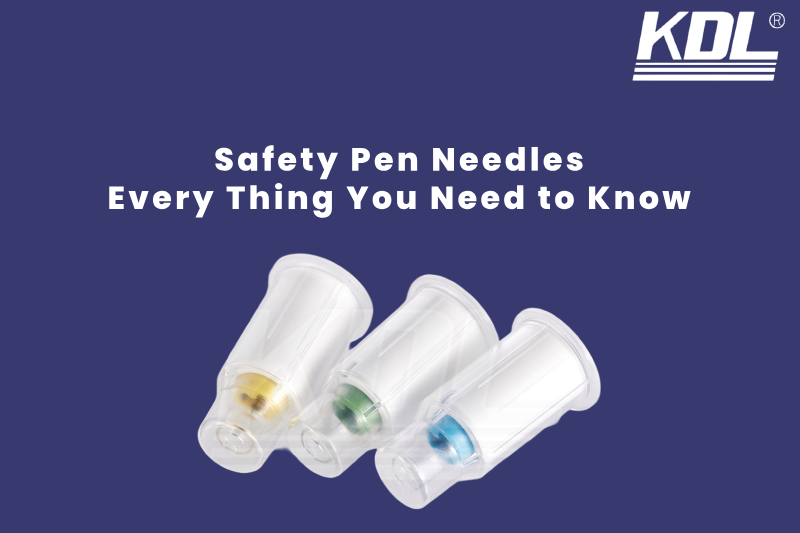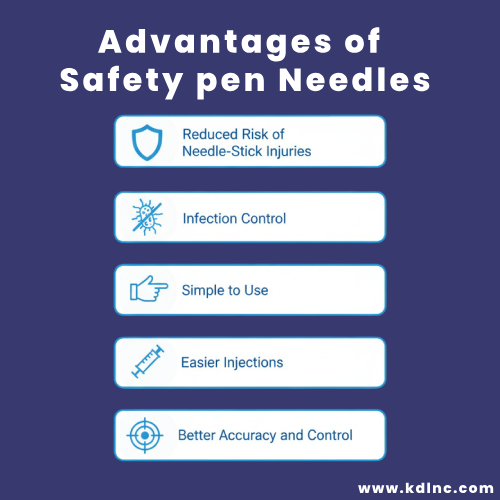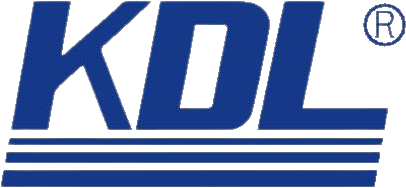
If you or someone close to you uses injectable medication, you might have come across safety pen needles. These handy little tools are all about making injections simpler, safer, and more comfortable for everyone involved, from patients to healthcare pros.
In this post, we’re going to talk about safety pen needles what they are, how they function, and why they’re becoming the go-to option for folks managing diabetes and other health conditions that need regular injections.
Let’s discuss about safety pen needles. We’ll cover all the important details, including their features, uses, and the main benefits they offer.
What Are Safety Pen Needles?
Safety pen needle are needles that are made to work with insulin pens and inject insulin into the body. Unlike regular pen needles, safety pen needles have features built in that help keep you from accidentally sticking yourself with the needle after an injection.
Most of the time, they come with a shield that automatically covers the needle after use to protect it. This makes them safer for both patients and people who work in healthcare.
Why Safety Pen Needles is important for people with diabetes
People who take insulin more than once a day are more likely to get needle sticks or cross-contamination. That risk is lower with safety pen needles because they don’t let you reuse needles and keep you from touching the needle after each shot.
These needles also make it less likely for nurses and healthcare workers to get pricked by mistake. This is especially important in hospital or home care settings.
Key Features of Safety Pen Needles
Safety pen needles come with several unique design features that make them stand out from regular pen needles. Let’s look at some of the most important ones.
1. Built-in Needle Shield
The built-in safety shield that turns on after injection is the most important part. The cover slides over the needle and locks it in place once the medicine is given.
Because the needle isn’t left out after use, it’s much safer to handle and throw away.
2. Ergonomic Grip and Design
A lot of current safety pen tips have sides that don’t slip and are easy to hold on to. This makes it easier for people to put the needle on, even if they have weak hands or trouble moving their fingers around.
3. Slim, Short Needles for Comfort
Nowadays, safety pen needles are usually really thin and short, coming in sizes from 4mm to 8mm. A thinner needle can really help with less pain and lower anxiety, which is great for those who have to deal with multiple injections every day.
4. Universal Pen Compatibility
Most safety pen needles work with all the big insulin pens and medication pens, so you really don’t have to stress about finding the “right” one. Brands like KDLNC, BD AutoShield Duo, Owen Mumford Unifine SafeControl, and NovoFine Autocover are designed to fit nearly all standard pen injectors.
5. Safety Indicators You Can See
Some models come with visual or audible signals that let you know when the injection is done and the safety shield is securely locked. This really helps to make sure the device is being used the right way.
Common Uses of Safety Pen Needles
Safety pen needles can be used with many types of injectable medications. Here are some of the most common uses.
1. Insulin Therapy
People mostly use it for insulin injections. People with Type 1 or Type 2 diabetes usually need to inject insulin multiple times throughout the day. A safety insulin pen needle makes each injection a lot safer and more comfortable.
2. GLP-1 and Other Diabetes Medications
Medications such as Ozempic, Trulicity, or Victoza come in pen devices. Safety pen needles can easily attach to these pens, providing users with a secure and user-friendly option.
3. Hormone or fertility treatments
Safety pen needles are used for things like hormone replacement therapy, growth hormone treatments, and fertility injections, including Gonal-f or Follistim.
4. Using Hospitals and Clinics
Healthcare professionals rely on safety pen needles to keep both themselves and their patients safe. In hospitals, safety devices are usually mandated by law to follow needlestick prevention guidelines.
Advantages of Safety Pen Needles
There are many reasons why both patients and professionals choose safety pen needles. Let’s explore their main advantages.

1. Reduced Risk of Needle-Stick Injuries
This is definitely the biggest perk! The safety shield automatically covers the needle right after it’s used, so there’s no chance of it accidentally poking anyone. This is really important for healthcare workers or caregivers who are giving multiple injections each day.
2. Infection Control
Used needles really rank high among the main reasons for accidental infections in medical settings. Safety pen needles are great because they help cut down on the risk of infections by keeping you away from used sharps.
3. Simple to Use
Most safety pen needles facilitate easy single-handed use. So, they’re really easy to attach, inject, and throw away, which is great for older adults or anyone with arthritis.
4. Easier Injections
The design of the thin, lubricated needle helps to cut down on friction, which means injections are smoother and less painful. For patients who feel anxious about needles, that can really help a lot.
5. Better accuracy and control
Many safety pen needles are craft to deliver medication at the ideal depth, effectively reducing leakage and preventing dosing mistakes.
How to Choose the Right Safety Pen Needle
There are many brands and models available, so it’s important to pick one that fits your needs. Here’s what to look for.
1. Needle Length and Gauge
In general, these are the sizes:
- 4 mm (31G or 32G): shortest, least painful, best for most people
- 5mm (31G): The correct length for adults
- 8mm (30G): This size is use for thicker skin or when you need a larger amount.
- Your doctor or nurse can tell you which size is best for your treatment schedule.
2. Compatibility with Your Pen
Make sure the needle fits the type of pen you have. It’s a good idea to make sure before you buy that the safety pen tip will work with any pen.
3. Easy It Is to Use
Some safety guards turn on by themselves, while others need a little push to work. If you have trouble moving your hands, pick a type that turns on by itself.
4. Cost and Availability
While safety insulin pen needle may cost slightly more than standard ones, they are worth it for the added protection. Many insurance plans cover them, so check with your provider.
Safety Pen Needles vs. Regular Pen Needles
Let’s compare them side by side.
| Feature | Safety Pen Needle | Regular Pen Needle |
|---|---|---|
| Needle Protection | Automatic safety shield | None — needle exposed |
| Injury Prevention | High | Low |
| Ease of Disposal | Safer, fully enclosed | Must be handled carefully |
| Cost | Slightly higher | Lower |
| Comfort | Similar or better | Standard |
| Use in Hospitals | Required or preferred | Limited use |
In short, safety pen needle are the smarter, safer choice for anyone who injects regularly — whether at home or in a clinical setting.
Who Benefits Most from Safety Pen Needles?
Safety pen needle use by anyone, but some groups really get the most out of them:
- People with diabetes who give themselves shots several times a day
- Older patients or individuals with less hand strength
- People in healthcare who frequently give injections
- Parents or caregivers administering injections to kids
- Hospitals and clinics that need to make sure they’re meeting safety compliance standards
Using safety pen needle in these situations isn’t just about making things easier — it’s really about keeping everyone safe.
Final Thoughts
The safety pen needle is a simple but useful improvement to insertion technology. With their built-in safety features, comfortable forms, and ability to work with all drugs, they help millions of people take their medicines more easily and with more confidence every day.
You can use a safety pen needle to give insulin shots at home or as a nurse in a busy clinic. They make the process faster, safer, and less stressful.
You should talk to your doctor or pharmacist about moving to disposable pen needles if you are still using the old ones. It might be one of the easiest ways to keep yourself and other people from getting needle sticks by mistake.
 +86-791-8686-1216
+86-791-8686-1216 

